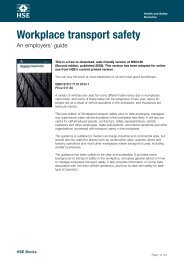Download - Arri
Download - Arri
Download - Arri
Create successful ePaper yourself
Turn your PDF publications into a flip-book with our unique Google optimized e-Paper software.
5 0 D i g i t a l I n t e r m e d i a t e S y s t e m s<br />
Fotokem Purchases<br />
ARRI Relativity Software<br />
FotoKem, a leading full-service motion<br />
picture post production house, has recently<br />
added the powerful Relativity software<br />
suite to their arsenal of existing ARRI Digital<br />
Intermediate Systems products including<br />
the ARRILASER and ARRISCAN systems.<br />
The Relativity suite offers innovative tools<br />
for fast, efficient and interactive control of<br />
image texture caused by film grain and<br />
electronic noise, as well as video standards<br />
conversion and content re-timing, all using<br />
sophisticated motion estimation techniques.<br />
Explains Paul Chapman, FotoKem’s Senior<br />
VP of Technology, “FotoKem and ARRI have<br />
had a long history and this is part of the<br />
reason why we are here together with Relativity.<br />
ARRI has a great reputation, not just<br />
as a product manufacturer but also with<br />
technology. We wanted to partner with<br />
ARRI for this exciting new tool.” The collaboration<br />
between the companies around<br />
Relativity began earlier this year when<br />
FotoKem hosted the product’s launch event<br />
for the American Society of Cinematographers<br />
at their Burbank facility.<br />
ARRI Relativity software is powered by Pixel<br />
Strings, the first engine to harness the<br />
potential of GPU-based parallel processing<br />
for motion estimation and spatial-temporal<br />
image filtering. In its most comprehensive<br />
version, the entire Relativity software bundle<br />
is currently comprised of four different<br />
applications: Texture Control, Clean, Film<br />
Simulation and SpaceTime Converter.<br />
Following a rigorous testing process, FotoKem<br />
configured the Relativity software for their<br />
particular needs to include Texture Control,<br />
Clean, Film Simulation and SpaceTime<br />
Converter. With Texture Control, one can<br />
manipulate the level of film grain and<br />
electronic noise, mixing and matching the<br />
textures of 16mm, 35mm and digitally<br />
acquired images for a particular effect or<br />
visual continuity, and (if desired) even<br />
generate synthetic grain with Film Simulation.<br />
Clean provides an efficient single pass<br />
removal of both white and black randomly<br />
located dust, fibres, and small scratches for<br />
material transferred from film. The SpaceTime<br />
Converter allows time resampling for<br />
creative tempo changes, slow motion and<br />
speed ramp effects. It also allows the<br />
conversion of any TV or motion picture<br />
format into another, with crop/zoom, spatial<br />
resampling, frame rate conversion, de-interlacing<br />
and addition or removal of 3:2 pulldown<br />
through an easy-to-use interface.<br />
Chapman notes, “Here at FotoKem we are<br />
implementing the frame conversion and<br />
grain reduction tools. We ran the software<br />
through a significant period of evaluations.<br />
Our team felt the tool was user friendly and<br />
effectively did the job in such a way that it<br />
increased productivity.<br />
FotoKem was established in 1963 and today<br />
the post facility offers a full menu of services<br />
for features and commercials including film<br />
processing, timing and printing, telecine,<br />
restoration, in addition to filed-based workflows,<br />
digital intermediate pipelines and<br />
services for new camera technologies<br />
including the ARRIFLEX D-21.<br />
An Tran<br />
Company 3 is a high-power grading<br />
and digital intermediate facility in<br />
the industry for feature films,<br />
commercials and music videos. To<br />
deliver the quality of work its clients<br />
demand, in 2007, Company 3<br />
acquired what it believes to be the<br />
best scanning technology available<br />
– ARRISCANs.<br />
After putting four machines into place,<br />
Colorist and Co-Founder Stefan Sonnenfeld<br />
and VP of Engineering, Mike Chiado,<br />
found they could efficiently utilize the<br />
ARRISCANs not only for theater-bound DI<br />
work, but also replacing many telecine<br />
services with true scanning for all filmoriginated<br />
material, including commercials<br />
and music videos.<br />
We spoke with Sonnenfeld and Chiado<br />
about their decision to use ARRISCANs for<br />
film-originated work, even in cases where<br />
the final delivery spec is an HD master.<br />
Why use a full-fledged scanner for<br />
commercials and music videos, rather<br />
than a telecine system if the final product<br />
isn't destined to be seen at a resolution<br />
higher than HD?<br />
Sonnenfeld: When it<br />
comes to feature DI work,<br />
the scanners enable us to<br />
bring more of the original<br />
image information from<br />
the negative to our colorists'<br />
bays. We want to bring<br />
the same level of quality to every film<br />
project we work on – whether it's features,<br />
commercials or music promos.<br />
Do you find that the quality difference<br />
between using a scanner, compared with<br />
telecine, holds up even if the final product<br />
is viewed at a lower-resolution HD format?
















